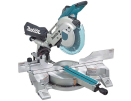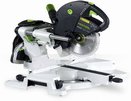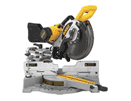Choosing the right miter saw for you or your shop can be a tough process, but it’s also one you’ll be glad you devoted some time to. Simply remember these few steps and ensure you’re investing the miter saw that is most compatible with you and with your individual needs.
STEP 1. Understanding the miter saw and what it can do for you
First it’s important to know how you’re going to use your miter saw. Homeowners and home-builders usually require two entirely different tools. Become familiar with the differences between a standard, compound, and sliding miter saw – The standard miter is the least expensive and usually offers the least features, it is, however, perfectly suitable for most homeowners. Compound miters are only a bit more expensive and have the ability to bevel cut, or tip the blade to either the left or right side (0° – 50°). Some can bevel in both directions allowing operators to miter and bevel within the same cut (-50° through 50°). A sliding miter is just like the compound saw but with the ability to cut dadoes and with extension rods that allow the saw blade and motor to move forward and back; this enables the cut length to be longer than the blade diameter. Sliding miters, consequently, are usually the most expensive. Serious carpenters, craftsmen, and contractors should invest in either a compound or sliding miter saw.
STEP 2. Determing size
Determine the blade size you’ll need from the tool. Blades size at 8”, 10”, and 12” (10” and 12” being the most popular). The price of the tool tends to rise with blade size, but similarly, so does your application base. The more you plan to do with your saw, the bigger you’ll want the blade to be. Many homeowners purchase a miter saw for home renovations and for projects like molding, the bigger the saw, the easier and more precise your final results will be. Allowing your needs to determine the size and power of a tool ensures you’ll be using the right one.
STEP 3. Research
Research brands to find which manufacturer meets the most of your needs. Here, there are a few things to consider; many craftsmen are already loyal to a specific brand, this shouldn’t stop you from cross checking other manufacturers to ensure your getting the most for your money. Additionally, not all tools or manufacturers are created equally; just like you, most manufacturers have a specialty, or a tool they build best – I like Festool, Makita, and Bosch for miter saws. Festool is always the most expensive investment, but if are lucky enough to own or have experienced Festool, you know why, and you know its worth it. Otherwise, Makita and Bosch produce extremely high-performance miter saws with a range of options to suit all types of users.
STEP 4. Setting a budget
After researching, you should also set a budget. Consider what you can, and are willing to pay for a saw, and keep in mind that it’s easy to both over and under-spend when purchasing power tools; if you have a limit already in mind, you’re much more likely to stick to it. Also keep in mind that cheap and expensive power tools are cheap and expensive for a reason. The expression “you get what you pay for,” is perhaps its most true in the tool industry.
STEP 5. Warranty
Check for a good warranty. Having a good warranty with your tool usually means you’re buying from a company that entirely trusts their product will satisfy you – this is a good feeling to carry with you on the job. Most industrial manufacturers include a one year warranty on their miters.
STEP 6. Tinker
Lastly, before you make the final cut, if you can, it’s good to tinker with the saw a bit to ensure the tool is comfortable under your operation. Many specialty stores will also provide tool demonstrations if you ask, this further ensures you are investing in the tool that most compliments your individual needs.
















